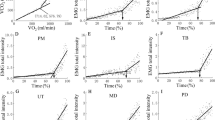Summary
The purpose of this study was to compare the physiological and biomechanical responses of wheelchair-dependent persons (WCD) to able-bodied persons (AB) during manual wheelchair ergometry. Five WCD and five AB performed a discontinuous wheelchair ergometer test starting at 12.8 W at 30 rev·min−1 (57 m·min−1) with increments of 7.0 W at 6-min intervals. Biomechanical data were collected 3.5 min into each stage followed by the collection of physiological data. After the fifth stage, peak oxygen consumption was determined by having the subject work against a resistance of 14.7–19.6 N at 30 rev · min−1. The WCD had significantly higher net mechanical efficiency at 26.7, 33.6 and 40.6 W in comparison to the AB. The WCD had significantly greater shoulder extension at the point of initial wheel contact as measured by the shoulder angle, while the AB had significantly greater shoulder range of motion at all work rates in comparison to the WCD. The results demonstrate that a significant physiological difference exists in the manner by which WCD and AB accomplish wheelchair ergometry. The biomechanical differences between AB and WCD were found to be a prominent factor contributing to the higher mechanical efficiency of WCD over AB. It was concluded that basic physiological and biomechanical differences exist between WCD and AB in manual wheelchair locomotion and that these differences are important considerations to the interpretation of data in wheelchair ergometry studies.
Similar content being viewed by others
References
American College of Sports Medicine (1986) Guidelines for graded exercise testing and exercise prescription, 3rd edn. Lea and Febiger, Philadelphia, p 32
Bidart Y, Maury M (1973) The circulatory behavior in complete chronic paraplegia. Paraplegia 11:1–24
Brattgard SO, Grimby G, Hook O (1970) Energy expenditure and heart rate driving a wheelchair ergometer. Scand J Rehabil Med 2:143–148
Engel P, Hildebrandt G (1974) Wheelchair design — technology and physiological aspects. Proc R Soc Med 67:409–413
Glaser RM, Sawka MN, Young RE, Suryaprasad A (1979) Metabolic and cardiopulmonary responses to wheelchair and bicycle ergometry. J Appl Physiol 46:1066–1070
Knowlton RG, Fitzgerald PI, Sedlock DA (1981) The mechanical efficiency of wheelchair dependent women during wheelchair ergometry. Can J Appl Sport Sci 6:187–190
Sanderson DJ, Sommer HJ (1985) Kinematic features of wheelchair propulsion. J Biomech 18:423–429
Sawka MN, Glaser RM, Laubach LL, Al-Samkari O, Suryaprasad AG (1980a) Wheelchair exercise performance of the young, middle aged, and elderly. J Appl Physiol 50:824–828
Sawka MN, Glaser RM, Wilde SW, Luhrte TC von (1980b) Metabolic and circulatory responses to wheelchair and arm crank exercise. J Appl Physiol 49:784–788
Sedlock DA, Knowlton RG, Fitzgerald PI (1988) The effects of arm crank training on the physiological responses to submaximal wheelchair ergometry. Eur J Appl Physiol 57:55–59
Statistical Analysis System Institute (1982) SAS User's Guide. Cary, North Carolina
Tahamont MV, Knowlton RG, Sawka MN, Miles DS (1986) Metabolic responses of women to exercise attributable to long term use of manual wheelchair. Paraplegia 24:311–317
Tupling SJ, Davis GM, Pierrynowski MR, Shephard RJ (1986) Arm strength and impulse generation: initiation of wheelchair movement by the physically disabled. Ergonomics 29:303–311
Woude LHV van der, Groot G de, Hollander AP, Ingen Schenau GJ van, Rozendal RH (1986) Wheelchair ergonomics and physiological testing of prototypes. Ergonomics 29:1561–1573
Author information
Authors and Affiliations
Rights and permissions
About this article
Cite this article
Brown, D.D., Knowlton, R.G., Hamill, J. et al. Physiological and biomechanical differences between wheelchair-dependent and able-bodied subjects during wheelchair ergometry. Europ. J. Appl. Physiol. 60, 179–182 (1990). https://doi.org/10.1007/BF00839155
Accepted:
Issue Date:
DOI: https://doi.org/10.1007/BF00839155




